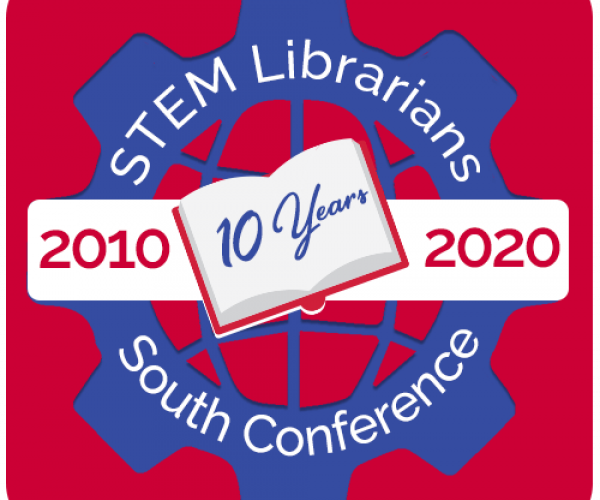
by Martin Wallace


by Martin Wallace
The STEM Librarians South Conference is an annual conference that focuses on topics related to STEM librarianship. Librarians from various types of libraries across the Southern U.S. meet to share ideas, current research, projects, and best practices that support STEM education and research. It is hosted at different institutions each year. It began in 2011 as the Texas STEM Librarians Conference and was hosted by UT San Antonio. The following years were hosted by UNT, UT Austin, Texas A&M, UTA, Baylor, UH, UT Austin and for the 2020 conference on July 16, SMU served as the host institution which was also the conference’s 10th anniversary. From the beginning, there were librarians from other surrounding states that attended and to make it more inclusive, in 2016 the conference attendees with the Steering Committee’s approval expanded the conference to all of the southern U.S. and the name changed to STEM Librarians South Conference. The conference was usually a day and a half long held in mid-July with a keynote speaker, presentations, occasional workshops, and a reception was usually held at a museum or unique restaurant venue. Conference attendance ranged from between 40-60 attendees.
By Antoinette Nelson
The 2020 planning committee consisted of Sylvia Jones, (Chair), Science & Engineering Librarian, SMU Libraries, Jolene de Verges, Director of Hamon Arts Library, SMU Libraries and Antoinette Nelson, Staff Engagement Manager, UTA Libraries. Sylvia and Antoinette have both served on the STEM Librarians Steering Committee various years. Planning began early December for the conference and we communicated via email and held bi-weekly meetings via Zoom. We used Box to communicate and keep all documents so access was attainable across two separate campuses.
Though the conference is hosted by different institutions, the logo was the same except using that institution’s colors. However, since this was the 10th anniversary, we redesigned it with the help of Candy McCormick’s expertise as the Web Graphic Designer at UTA to include the addition of the 10th anniversary ribbon. Letters were sent out to previous vendors for sponsorships that would help cover various costs of the conference, since the registration fee was nominal and affordable. We identified and contacted a potential keynote speaker and contacted various venues for the evening reception. CFP’s went out via various library email lists in early February with notification of accepted proposals in early April.
Then, COVID-19 hit! We transitioned from planning a physical conference to a virtual conference which was a first for all three of us. We decided to not charge for the conference and registration opened up June 1st. We had several meetings with SMU’s IT department to help setup the virtual conference via Zoom and one of their student employees helped us with behind the scenes operations. Ultimately we had approximately 300 registered for the conference with 15 presenters of which included UTA Libraries’ Martin Wallace, Nicolas McClintic, Laura Haygood and Ann Serrano.
Each of the organizers served as moderators for the various presentations that were given along with a short Q&A afterwards. Information about the conference can be found at: https://guides.smu.edu/stemlibconference and the presentations along with the recorded session of the Welcome by SMU Libraries Dean Holly Jeffcoat and the keynote speaker are posted in SMU’s Institutional Repository at: https://scholar.smu.edu/stemlibsouth_conference/. Overall, we felt our first virtual conference was a success.
By Antoinette Nelson and Martin Wallace
The keynote speaker was Dr. Eva Csasky, Executive Director of the Hunter and Stephanie Hunt Institute for Engineering and Humanity at SMU’s Lyle School of Engineering. Dr. Csasky’s talk included her own personal experiences about the library of Karl Marx University for Economics where her mother was a librarian and there is a picture of her mother still hanging on the wall.
In this position, she is developing projects and initiatives in collaboration with academia, the private sector and not-for-profit organizations that benefit disadvantaged communities, both locally and around the world. Prior to joining SMU, Eva worked for the World Bank Group for 15 years with a focus on market-based solutions for environmental and social problems. She led the design and implementation of projects in 24 different countries around the world and led programs and initiatives in areas including energy efficiency, renewable energy, energy and clean water access. Once at SMU, Dr. Csasky turned much of her attention to local problems such as food deserts and income inequality right here in the Dallas-Fort Worth area, noting how we tend to think of these problems as happening somewhere else when in fact some of the worst is happening right here in our own cities.
Eva's award winning efforts include a $250 million public-private energy efficiency partnership and a $120 million energy efficiency retrofit for low-income households. She also worked extensively in the area of sustainable value chains in collaboration with major global companies, focusing on agri-food and garment value chains. Eva was recently the recipient of the first ever World Bank Innovation Award.
By Laura Haygood
Hi! My name is Laura Haygood and I’m an Experiential Learning Librarian at UTA Libraries. I collaborated with a colleague, Ann Serrano, on a presentation about how we started using Microsoft Teams in the Libraries, and how we expanded that use to teach advanced searching techniques to nursing students.
UTA Libraries chose Microsoft Teams for online instruction for multiple reasons. As a university-approved communication method, Teams replaces a hodgepodge of unapproved tools, thus creating a centralized space for collaborative work. In Teams, users may share files, chat, video conference, and work simultaneously on documents. Due to these features, and because all university affiliates have access, Teams was the best option for online instruction.
Our presentation highlighted what we learned about using Teams in a STEM field for reference and instruction, as well as the technical challenges of being an early adopter in the academic library field. Additionally, we stated the pros and cons of using Teams and what best practices we recommend for meetings in Teams. We also discussed the synchronous and asynchronous methods we used to provide library instruction, including making recordings available to students after the fact. Finally, we covered how we used a polling feature in Teams to keep students engaged with our instructional content, tsess student comprehension, and to help with the pacing of instruction.
In addition to presenting, I enjoyed attending many of the other sessions, presented by STEM librarians across the region. UT librarians Roxanne Bogucka and Hannah Chapman Tripp presented one session I particularly appreciated, covering their research on academic conference participation. Ms. Bogucka and Ms. Tripp’s presentation, Academic Librarians’ Participation in Non-Library Conferences, explored librarian involvement in conferences specific to their subject of expertise. Sixty percent of the study participants reported that they viewed the value of attending these conferences as “extremely positive.” Participants also reported that the largest deterrents to participating in these conferences were time and money.
My coworkers and I enjoyed being able to engage with our colleagues in the region virtually; we appreciate the planning committee’s work in creating a great conference!
By Martin Wallace
A UTA Libraries student employee, Nicolas McClintic, and I presented on how UTA Libraries is fostering student engagement with drones, robotics and electronics through informal tinkering and exploration programs such as Tinker Time and Drone Club. This informal training effort was created in preparation for rollout of our new drone, robotics and electronics space coming in spring 2021, and our need to prepare our student employees to be able to provide good user service when that takes place. I provided a brief intro about UTA Libraries Tinker Time and Drone Club initiatives, and Nicolas talked about his role from the student employee perspective, focusing on digital creation software, the experience of working with this team, and the lesson plans he created.
I appreciated hearing Jay McAllister’s presentation about Libraries and the Engineering Process. Jay, a librarian at the University of Arkansas, described working as an embedded librarian in an industrial engineering undergraduate course, and how he used engineering design principles to engage students in the course. He identified problem goals such as his need to understand more engineering context, and the students’ needs to know more about how library services work. By being embedded, he was able to accomplish much of both. I was curious about how he assessed his work, and he said that they have all the assessment methodologies available and he’s be happy to share with me.
I was also happy to see Maria Boswell from Arlington Public Library present on Robotics: from Classes to Competitions. Maria described the robotics program as a way to help students learn to think and work through problems by using robotics as a learning tool, not a Robotics training course per se. She began the program not knowing anything about robotics, and found that the students often knew more than she did. The program led to a competition where students try to solve a problem using Lego Mindstorms its. Her experience with creating a robotics program having no prior knowledge resonates with my own experience, and I look forward to discussion more with Maria on this topic, and possibly collaborating in the future.
Add new comment